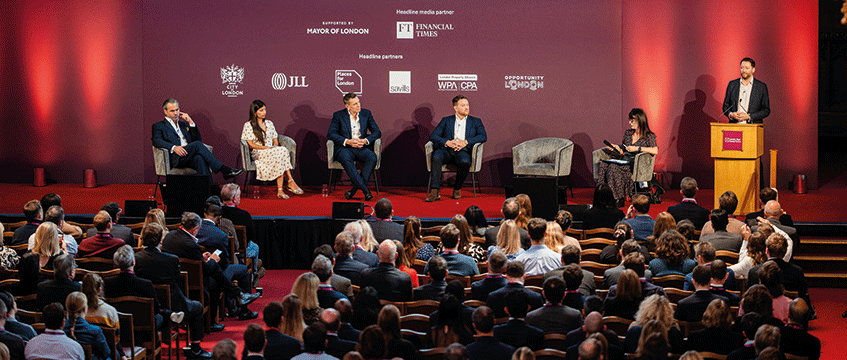While investment in London has been slow this year – running at £6.3bn in H1, some 41% below the 10-year average – panellists at the London Real Estate Forum agreed there are reasons to be hopeful.
“There are people out there who say that when Keir Starmer became Labour Party leader he found a magic lamp and made three wishes,” said Chris Hare, a senior economist at HSBC. The first was “the collapse of the Conservative Party”, while the second was a “pick-up in economic activity around the time he would assume the office of prime minister”.
The experts
- Chris Hare, senior economist, HSBC
- Lee Coward, vice-president of investments, Oxford Properties
- Alexa Baden-Powell, senior investment manager, GPE
- Rob Codling, senior fund manager, Legal & General Investment Management
- Richard Garside, head of central London & international investment, Savills
- Susan Freeman, partner, Mishcon de Reya
Both, Hare said, seem to have been achieved, following a landslide victory over the Conservative Party, recent GDP growth and falling inflation.
And Hare said his team at HSBC are expecting the third wish – “for a sustained rate of fairly decent economic growth” – to come true as well.
While household spending is still lacklustre, Hare said this could change as inflation and interest rates fall. He expects rates to fall by 25 basis points in each of the eight policy meetings scheduled for next year.
Alexa Baden-Powell, senior investment manager at Great Portland Estates, said “now is a fantastic time to be buying”.
With valuations low and yields high, Baden-Powell said there had been less competition for assets, which made the prospect of investing attractive – especially in light of the government’s expressed intent to improve certainty around planning policy.
Lee Coward, vice-president of investments at Oxford Properties, was similarly optimistic. “In a way, I love hearing transaction volumes are down because it just means there are not that many people chasing opportunities,” he said. “Post-GFC, the best returns we made were by being bold and going early and doing things that other people weren’t.”
Explaining his company’s strategy, Rob Codling, senior fund manager at Legal & General Investment Management, said: “Our exit capacity is key. These options we are looking at are typically around £75m to £90m. We are very conscious of that to make sure we are not getting past that £100m-plus. That is where it gets far harder [to sell].”
And he added: “We won’t take any risk over location. Because location is absolutely key to make this work. And that is something we very much believe in.”
Richard Garside, head of central London & international investment at Savills, said that while the first half of the year was very challenging, the second half could bring some respite if transactions from bolder investors start to trickle through.
He said that wider change would come through more risk-averse overseas investors, which make up most of the investment market in London. “To bring back that overseas capital – London still remains the number one in that cross-border market – we need to set more data points,” said Garside.
He explained that these data points allow for greater clarity in the market, since they give investors more information to work with to calculate the costs and returns involved in investments.
As these data points – or transactions – accumulate, momentum could gather and bring about change.
“That will have a little bit of a ripple of confidence across the wider market,” said Garside.
Image © BAR Productions
Send feedback to Dominic Plaskota
Follow Estates Gazette











